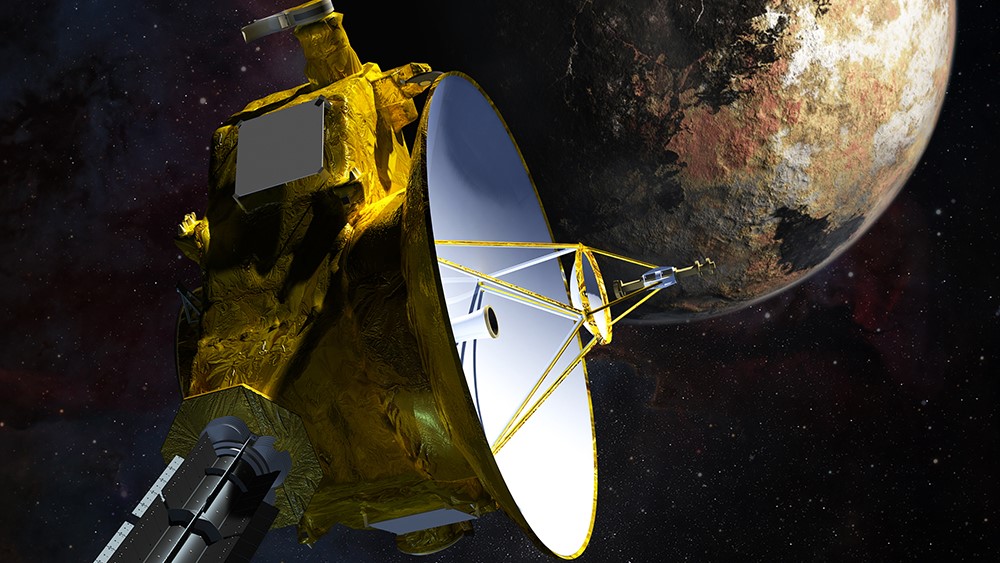NASA’s New Horizons spacecraft has been used to demonstrate simple interstellar navigation by measuring the parallax of just two stars. An international team was able to determine the location and heading of the spacecraft using observations made from space and the Earth.
Developed by an international team of researchers, the technique could one day be used by other spacecraft exploring the outermost regions of the solar system or even provide navigation for the first truly interstellar missions.
New Horizons visited the Pluto system in 2015 and has now passed through the Kuiper Belt in the outermost solar system.
Now, NOIRLab‘s Tod Lauer and colleagues have created a navigation technique for the spacecraft by choosing two of the nearest stars for parallax measurements. These are Proxima Centauri, which is just 4.2 light–years away, and Wolf 359 at 7.9 light–years. On 23 April 2020, New Horizons imaged star-fields containing the two stars, while on Earth astronomers did the same.
At that time, New Horizons was 47.1 AU (seven billion kilometres) from Earth, as measured by NASA’s Deep Space Network. The intention was to replicate that distance determination using parallax.
Difficult measurement
The 47.1 AU separation between Earth and New Horizons meant that each vantage point observed Proxima and Wolf 359 in a slightly different position relative to the background stars. This displacement is the parallax angle, which the observations showed to be 32.4 arcseconds for Proxima and 15.7 arcseconds for Wolf 359 at the time of measurement.
By applying simple trigonometry using the parallax angle and the known distance to the stars, it should be relatively straightforward to triangulate New Horizons’ position. In practice, however, the team struggled to make it work. It was the height of the COVID-19 pandemic, and finding observatories that were still open and could perform the observations on the required night was not easy.
Edward Gomez, of the UK’s Cardiff University and the international Las Cumbres Observatory, recalls the efforts made to get the observations. “Tod Lauer contacted me saying that these two observations were going to be made, and was there any possibility that I could take them with the Las Cumbres telescope network?” he tells Physics World.
In the end, Gomez was able to image Proxima with Las Cumbres’ telescope at Siding Spring in Australia. Meanwhile, Wolf 359 was observed by the University of Louisville’s Manner Telescope at Mount Lemmon Observatory in Arizona. At the same time, New Horizons’ Long Range Reconnaissance Imager (LORRI) took pictures of both stars, and all three observations were analysed using a 3D model of the stellar neighbourhood based on data from the European Space Agency’s star-measuring Gaia mission.
The project was more a proof-of-concept than an accurate determination of New Horizons’ position and heading, with the team describing the measurements as “educational”.
“The reason why we call it an educational measurement is because we don’t have a high degree of, first, precision, and secondly, reproducibility, because we’ve got a small number of measurements, and they weren’t amazingly precise,” says Gomez. “But they still demonstrate the parallax effect really nicely.”
New Horizons position was calculated to within 0.27 AU, which is not especially useful for navigating towards a trans-Neptunian object. The measurements were also able to ascertain New Horizon’s heading to an accuracy of 0.4°, relative to the precise value derived from Deep Space Network signals.
Just two stars
But the fact that only two stars were needed is significant, explains Gomez. “The good thing about this method is just having two close stars as our reference stars. The handed-down wisdom normally is that you need loads and loads [of stars], but actually you just need two and that’s enough to triangulate your position.”
There are more accurate ways to navigate, such as pulsar measurements, but these require more complex and larger instrumentation on a spacecraft – not just an optical telescope and a camera. While pulsar navigation has been demonstrated on the International Space Station in low-Earth orbit, this is the first time that any method of interstellar navigation has been demonstrated for a much more distant spacecraft.
Read more

New Horizons probe may have observed light from decaying dark matter
Today, more than five years after the parallax observations, New Horizons is still speeding out of the solar system. It has cleared the Kuiper Belt and today is 61 AU from Earth.
When asked if the parallax measurements will be made again under better circumstances Gomez replied. “I hope so. Now that we’ve written a paper in The Astronomical Journal that’s getting some interest, hopefully we can reproduce it, but nothing has been planned so far.”
In a way, the parallax measurements have brought Gomez full-circle. “When I was doing [high school] mathematics more years ago than I care to remember, I was a massive Star Trek fan and I did a three-dimensional interstellar navigation system as my mathematics project!”
Now here he is, as part of a team using the stars to guide our own would-be interstellar emissary.
